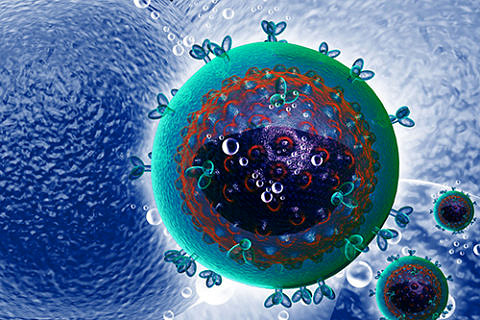HIV remains highly active despite therapy
FAU researchers believe virus hides in an unknown location in the body
The introduction of HIV combination therapy in the mid 1990s is considered one of the greatest successes in modern medicine and has saved countless lives to date. It is commonly accepted that the cocktail of different medications used in this therapy causes the virus to enter a dormant state and suppresses its reproduction. However, a team of medical researchers from Universitätsklinikum Erlangen at Friedrich-Alexander-Universität Erlangen-Nürnberg (FAU) now believe that this may not be the case. A team of FAU researchers have shown that the virus remains highly active despite the therapy. Their results of their research have recently been published in the journal EBioMedicine.
Shortly after beginning treatment with the cocktail of medications, the virus is usually no longer visible in the blood of HIV patients. It survives only in a small number of cells where it is largely inactive, essentially dormant, and no longer reproduces. This has been the general consensus in HIV research for around 20 years.
However, according to Erlangen-based medical researcher Prof. Dr. Andreas Baur, there are several indications that contradict this understanding. If therapy is suspended the viral load in the blood increases considerably within just a few days and the patient’s health deteriorates. Furthermore, despite treatment, people with HIV suffer more frequently from cancer, arteriosclerosis and Alzheimer’s disease. In addition, many patients – around one third – have a very low number of a type of defence cell known as T helper cells, as is also the case in people with an untreated HIV infection. The FAU team consider this an indication that large quantities of highly active HIV must be hiding somewhere in the body and continuing to attack it – even when patients are taking their medication regularly.
Professor Baur’s team has uncovered clear signs that support this hypothesis in extracellular vesicles – tiny bubbles that transport substances between cells. The starting point for their discovery was the finding that the number of these vesicles increases by up to 20 times in case of HIV infection and does not return to a normal level despite efficient treatment. The FAU researchers investigated the vesicles more closely and were surprised to find that they contained a large number of proteins that only occur when HIV reproduces. They were also surprised to discover that the higher the number of these proteins found in a patient’s blood, the lower the number of T helper cells. The number of T helper cells usually decreases dramatically if the HIV infection is active, bringing the immune system to a standstill. No previous research has been able to establish a direct link between the number of these cells and a particular mechanism.
‘We believe that these findings indicate that there must be a previously undiscovered reservoir of the virus somewhere in the HIV patient’s body that remains highly active despite treatment,’ Professor Baur explains. ‘A therapy that specifically targets this reservoir could considerably improve or even revolutionise HIV treatment.’
Contact for the press
Prof. Dr. Andreas Baur
Phone: +49 9131 8539534
andreas.baur@uk-erlangen.de
